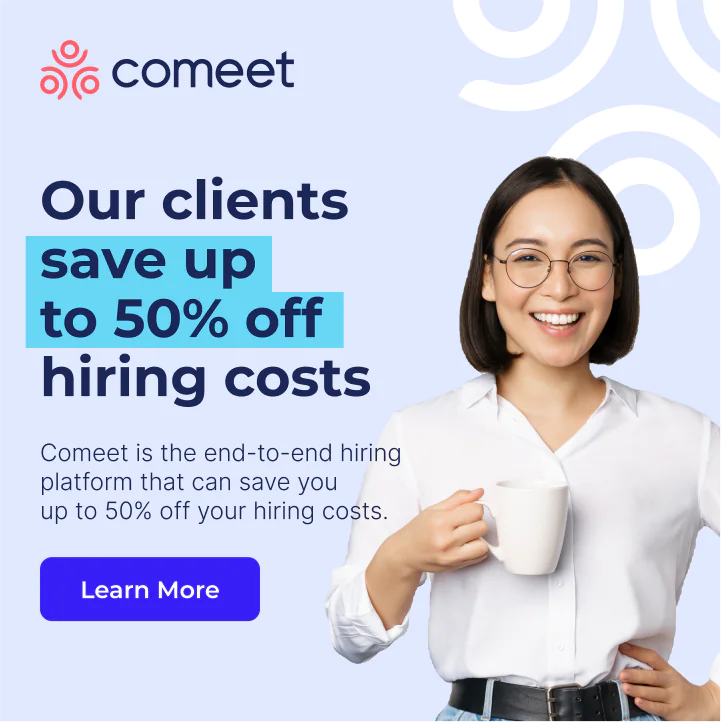Regardless of what approach you take in your recruiting efforts, whether using a retained search firm, sourcing candidates directly yourself, posting on job boards, etc., one of the first and most important parts of your hiring process is creating a job description.
Crafting a compelling job description, while seemingly simple and easy to do, can have a powerful impact on the success of your recruiting efforts and most importantly, who eventually ends up in the role at your company. Because that’s what it’s all about, right?
Read on to learn how to write a stand-out job description. You can also check out our resources center of 400+ job description templates to get started immediately.
How To Write A Compelling Job Description
But First, Why Is The Job Description So Important?
The way to think of your job description is the same way your sales and marketing team think about their external-facing materials, from collateral to the website. When you’re selling your own company’s products and/or services, you need to make sure you’re presenting your company and offerings not only in the best possible light but in a differentiated and engaging position.
The role you’re “selling” should be treated the same way. There are hundreds of available opportunities out there for the best candidates; why should they be interested in and respond to yours? Only by making your job profile understandable and attractive, will candidates want to “buy” what you’re, in fact, selling.
Ready to get started? Before diving in, let’s see what you don’t want to do!
Reasons Why You’re Missing Out On Top Talent
You’re Focusing Only on Job Requirements
The old way of marketing was a “let me tell you about us” approach, but that no longer works. It’s all about the customer now, and the same holds true in recruiting. While you don’t want to ignore the skills and qualifications needed to succeed, focus on the candidate and what she can gain, only with your opportunity.
You’re Not Talking About Your Company’s Characteristics
Whether you’re a 10 person startup or a Fortune 500 company, candidates care today about whom and where they’re going to be spending most of their waking hours. When you ignore what’s unique about your environment, (or worse, seem like you’re afraid to highlight your environment) candidates are much less likely to want to expend their own energy to learn about whether it’s a good fit.
You’re Ignoring Selling Your Perks & Benefits
If you didn’t hear, it’s an incredibly competitive market to recruit the best candidates. Most every company has an attractive set of perks and benefits. Not highlighting what you offer can make it seem like you’re the exception and lead a candidate to move on to the next potential opportunity and not pursue yours.
You’re Making Your Job Description Relevant to Everyone
If you’re pitching to everyone, in practice, you’re likely deeply resonating with no one. If you don’t have a target audience in mind (SaaS sales reps experienced selling in the SMB sector, front end designers focused on consumer user experience, etc.), your description will miss what’s most important and not sound compelling or particularly attractive to those to whom it’s most applicable.
Now that you know what not to do, let’s look at how to actually create a compelling job description that will attract those highly sought candidates that you want to join your company. If you’ve typically whipped off a job description quickly in the past, this may seem a bit much. But today, it’s important to engage the best candidates right from the start. Here, we detail all the parts of writing job description that will help your opportunity stand out from the crowd.
Most Important Elements of a Job Description
Before you get started, make sure you’ve put the time in to get all the information about the role (from the hiring manager if you’re the recruiter). Once you know what’s important about the role, let’s get to the key elements in putting your job description together. Some may be obvious, but you may want to look at them differently. And others are ones you should consider including if you don’t typically.
| Job Title | It sounds like this should be the easiest when composing your job description. But think of this like your book cover or party invitation, it doesn’t tell everything but done properly, can engage the candidates you really want.
What’s most important is to be specific if the role calls for it. Don’t advertise for a “marketing manager” if what you really are looking for is a “demand generation manager” or a “content marketing manager” or a “social media marketing manager.” If you don’t say what you’re looking for, it makes it that much harder to make sure you get exactly what you need. |
| Location | This should be straightforward but with more and more companies geographically distributed and managing remote workforces, job location should be spelled out. If the position can be based from any of your locations or even be remote, spell that out. And be clear about what ‘remote’ really means at your company (e.g., 100% or on-site 2-3 times per month). |
| Job Responsibilities | It’s best to move from a more rigid ‘requirements’ approach (which is company-centric) to more of a ‘what you’ll be responsible for’ approach (more candidate-centric). You want to let job seekers know what’s in it for them, what they’ll do and what their responsibilities will be.
Ideally, you should share this information in a day-to-day format or some type of ‘day in the life’ fashion. Tell a story so your ideal candidate can see herself in the role. If you’re a multi-product company, let her know which specific products she’ll focus on, if relevant. For many candidates, you need to convince and sell them on why they should move, so you want to start getting them thinking about exactly what they’ll be doing. And for many roles, it may even make sense to touch on what the next step in the candidate’s career at your company could be (e.g. “most successful sales development reps move into account executive roles within 18-24 months”). |
| ‘Nice to Haves’ | This is where you can really hone in on special skill sets or experiences that would be particularly useful for a candidate. You do want to be careful in crafting a position description so as not to add so many criteria that you end up scaring away everyone.
But giving them a sense of some of these desired but not required requirements, you can pique the interest of those that do have them, as well as give candidates the sense of what they’ll likely end up learning in the role. |
| Challenges | Following on responsibilities, you can take this next step and engage them with the types of problems they’ll face in the role – and that you’re looking for them to help solve. And don’t forget to let them know how their work will impact the overall success of the business.
The best candidates will get excited about jumping in and helping, and importantly, you’ll be able to get much deeper, quicker in interviews, by discussing real life issues related to the nuances of the role. Ideally, they’ll come prepared with ideas and new approaches already! |
| Learning Opportunity | Your best employees have a continuous learning mindset; those are the types of people you want to attract. Let them know what they’ll learn and be able to dive deeper into to build their own expertise. Don’t forget that you need to attract candidates from where they currently are; give them a powerful reason to explore your opportunity.
Everyone wants to make sure they start off strong in a new job and are in a position to succeed. If you have a strong employee onboarding program, don’t forget to include this as it demonstrates your commitment to a candidate’s success. As it’s not something everyone has or does, positioned properly, programs like this can be a real differentiator for some candidates. |
| Organizational Structure | While you don’t need to include a whole org chart, it’s helpful to give candidates insight into exactly who’ll they’ll be reporting to, whether they’ll have any direct reports and any relevant peer positions with whom they’ll regularly be interacting. Understanding their role in the company is important to gauge how they can impact its success. |
| Success Criteria | Make sure you or the hiring manager have thought through the goals for the role, and specifically what you’d like to see accomplished 3 months, 6 months and/or a year out. By defining what success looks like, you’re assured that whom you’re hiring knows what they’re getting into.
And again, top candidates want to make sure they’re going into a position to succeed (not just to have a job) so it’s essential that the goalposts are set and known. |
| Team & Colleagues | Does the team or organization have uniquely talented individuals? Strong backgrounds and/or successful exits from previous gigs? Special skills or accomplishments? Don’t be bashful about promoting the group that candidates will get to work with regularly. Your new hire will spend most of their waking lives with these people so get them excited to spend time with their new colleagues. |
| Culture & Atmosphere | This is not one to shy away from. Too many job searches fail at the end due to perceived “poor culture fit.” Be up front about what your company’s like both to excite those to join and screen out those who don’t want such a culture and will self-select themselves out.
Remember, company culture is more than foosball tables. Highlight what’s really unique about your environment, whether it’s your social mission, regular after-work bonding, distributed environment, non-hierarchical management structure, job rotations, travel opportunities, highly collaborative atmosphere, pet friendly workspace, etc. The key is to truly detail what it’s like to work at your company while not sounding like every other similar company. |
| Benefits & Perks | Hiring is becoming more and more competitive and job candidates are certainly looking at what your company is offering, beyond at least a market-based comp package (you have made sure of that, right?). While a certain level of benefits is expected in most sectors (health insurance, PTO, etc.), don’t forget to entice potential candidates with what else they can experience working for you.
Company lunches or breakfast every morning? Real ‘work from home’ opportunities? Special training & education sessions? Child care coverage or education benefits? Remember, the best job candidates have lots of options; make sure to sell them on why they should work for you. (And if you can’t, that might be something to work on!) |
| Recruiting Process | Transparency is key throughout the candidate journey. Too many candidates today are turned off, from long and never ending hiring hoops to jump through to simply being ghosted – even after in-person interviews – and never hearing from potential employers.
To protect your employer brand, you certainly don’t want to do that. But a best practice is to simply lay out exactly what they’ll face: initial phone screens, in person interviews, etc., and approximately how many and with whom. For example, highlighting a final round with a senior executive can demonstrate the importance of the particular role to a candidate. Of course, make sure you have a collaborative recruiting platform or applicant tracking system so you can stay on top of where every candidate is throughout the process and easily communicate with them at every step. Dropping the ball is the easiest way to lose a potential top candidate. |
Got all that? Does this sound too long? Depending on the role, you may not need to go into detail on every one of the aforementioned elements but you should review and consider each one when putting together your job description.
We know that running a successful recruiting program is hard. Your mantra today needs to be: Always be selling! It’s simply not enough to put out a standard job description sample for the role and wait for candidates to come to you. Posting generic sounding job specifications just doesn’t work anymore to attract the right candidates.
Lastly, with all the elements of your job description set, review these important points to make sure your job posting has the impact you want it to have.
What Not to Forget When Writing a Job Description
Use the Right Language & Tone
What kind of company and environment are you, really? Is it a serious workplace that’s somewhat formal, or one with a loose, fun atmosphere. Words and tone candidates read and hear matter. The language you use throughout the job description should indicate what you’re like, and more importantly, the type of person you’re seeking. This is often the first experience a candidate is having with your corporate brand. Make sure you’re presenting the opportunity in a way that expresses the particular characteristics of your firm.
Be Specific
There are too many broad stroke job descriptions that either don’t engage candidates or end up attracting way too many unqualified candidates. Don’t worry about narrowing the pool if there’s a particular skill set you’re seeking, if that’s really what you need. The goal isn’t to get lots of candidates that you end up having to pass on. Fish for just the kind of fish you want – be a fly fisherman casting just the right fly to get the elusive prize, not a trawler hauling up everything in the sea.
Be Inclusive
There’s lots of talent in the marketplace and to end up with the best candidate pool (and hires) you want to cast a wide net. Building a diverse workforce has proven to deliver the best results so make sure you’re not inadvertently turning away any candidates you should be meeting by how you’re composing your job description. Make sure it works for everyone.
Stop Unicorn Hunting
Everyone wants the best candidates and employees. But let’s be real. You’re not getting a manager-level candidate with 10+ years of experience in every aspect of the job. When a candidate reads a laundry list of job requirements that no one could possibly have gained (especially the “5+ years experience” in the new technology that’s only been out for about 3 years), it smacks of a company with either unrealistic expectations or worse, cluelessness in its own space. Neither will engage qualified candidates.
Borrow Judiciously
Every hiring manager and recruiter has seen job descriptions that make you go, “that’s a great description, it really gives me a great feel on the opportunity.” Save those. You don’t want to simply copy but there’s usually something you can learn from the best job descriptions you see. Keep a file of those and review them periodically to see how you can use the best elements from them.
For some JD inspiration to get started with, check out our bank of 400+ job description templates.
Demonstrate Consistency
While every role in your company will be different, your company’s your company. Candidates may review multiple positions at once, or come back months later when the role or timing is appropriate. It’s important that the commonalities across positions (company overview, culture, benefits, etc.) are consistent or at least highly similar. When candidates read multiple job postings and each one sounds like it comes from a different organization, it raises red flags. Make sure that hiring managers are not developing one-off (and off brand) job descriptions. Again, having a recruiting software system in place is a good way to make sure everyone can work together effectively.
Get the Right Folks to Review It
Like any external content you put out there, whether a blog post, sales collateral or product video, it’s worth getting a second (and third!) set of eyes on it. In addition to simply catching typos or poorly crafted language, it’s best to have team members who are in the role (or a similar one) let you know if you’ve properly captured what they find most interesting and exciting about the role (what do they look forward to each morning?). And if it’s a new role, reach out to colleagues that will work with the person to make sure it’s what they understand it to be (particularly as they’re likely to be part of the interview process).
Continuous Improvement for Recruiting
If you’ve followed everything here, you should be swimming in a highly qualified pool of attractive job candidates interested in your job position. But if you’re finding after enough time, that you’re not quite getting enough of the right candidates, don’t be afraid to iterate. You’re not tied to keeping your job description static.
Bring in some other people and get some more feedback. Revise and/or expand the job description if it doesn’t seem to be working. And when you’re speaking with relevant applicants, ask them what piqued their interest in the job description. See what they’re asking as well about the description. If many bring up the same questions, or are confused about the same things in the role or your company, update the job description accordingly.
The more job descriptions you write, the better you’ll get. Many of the sections, once composed and proven successful, can be used again (e.g. company culture, benefits & perks), making future job postings that much easier to develop.
Good luck, and if you have questions about what makes a strong and compelling job description, we’d be happy to discuss!
Are you looking to start your hiring process today? Comeet can help. Check out our pricing plans to learn more about how we can redefine the way you recruit new talent.





























